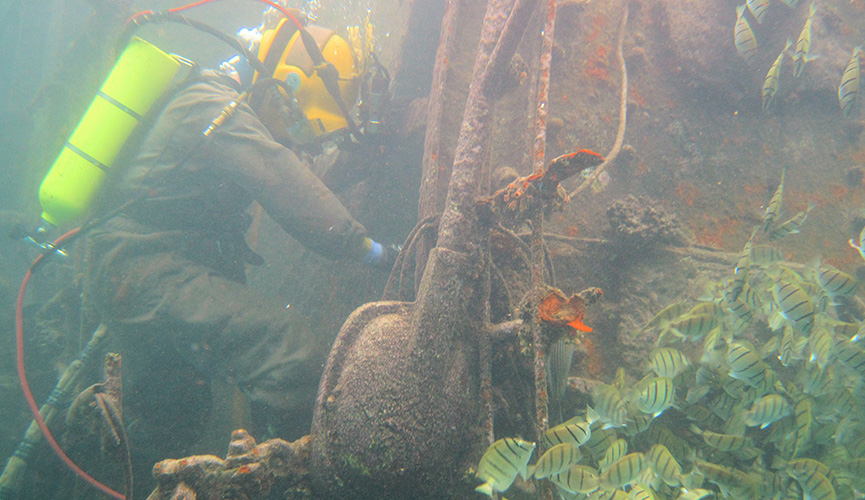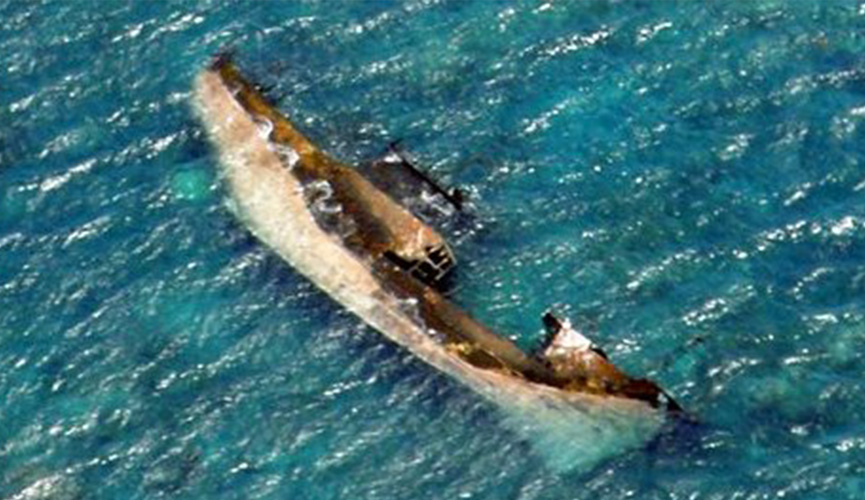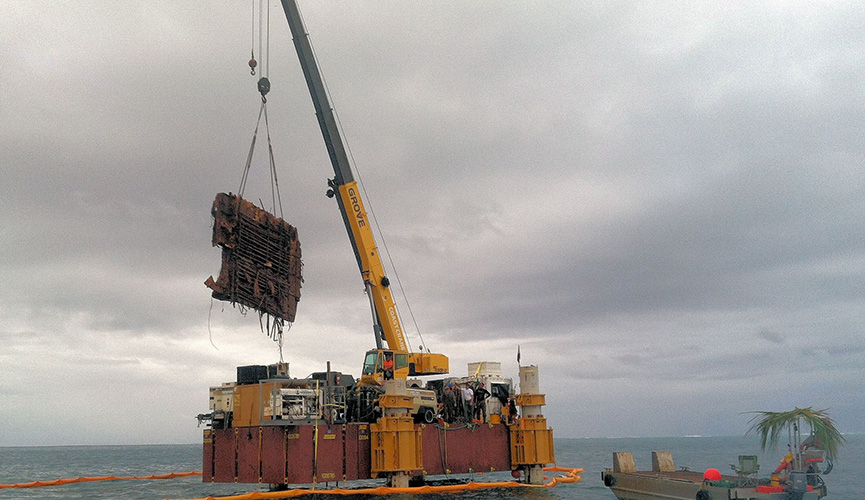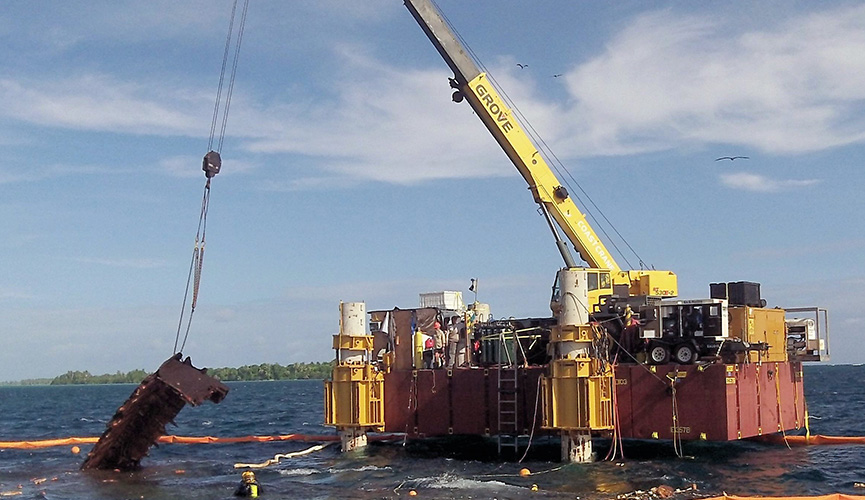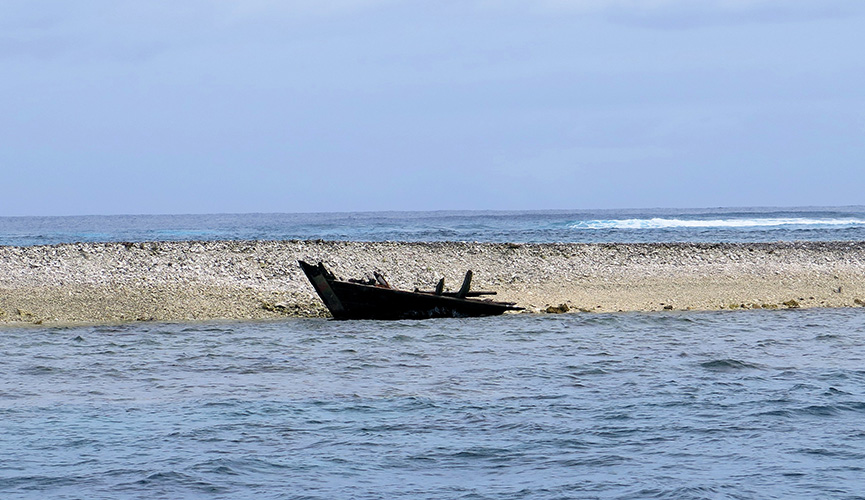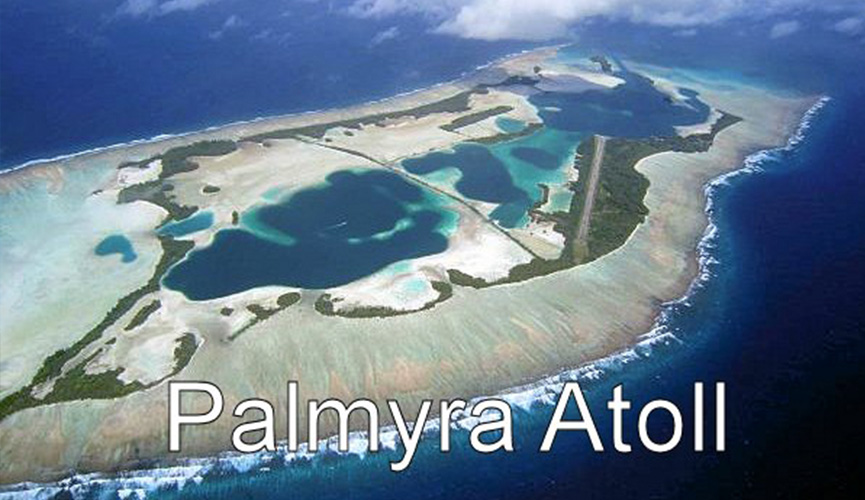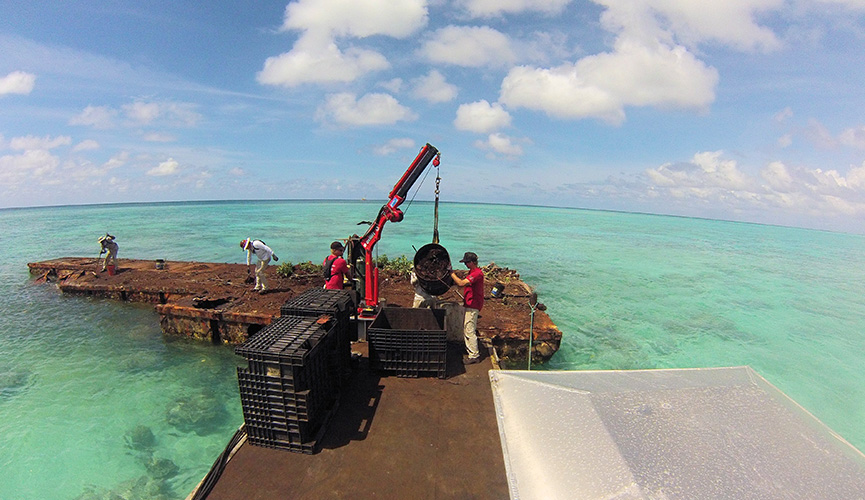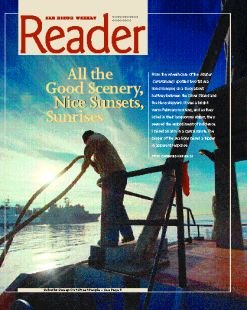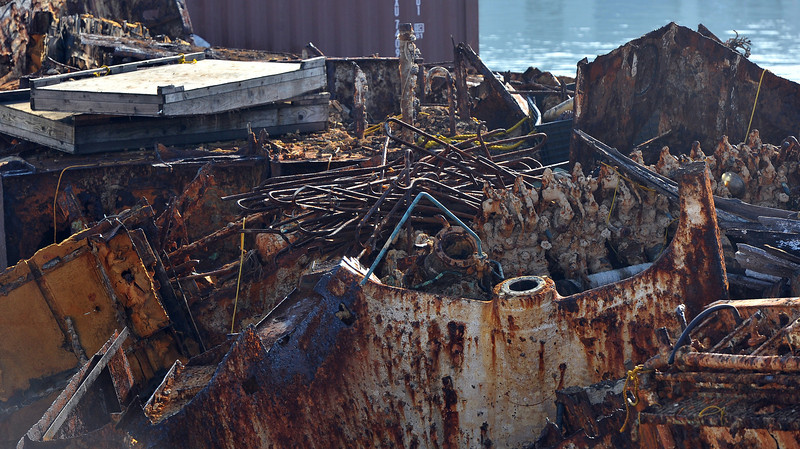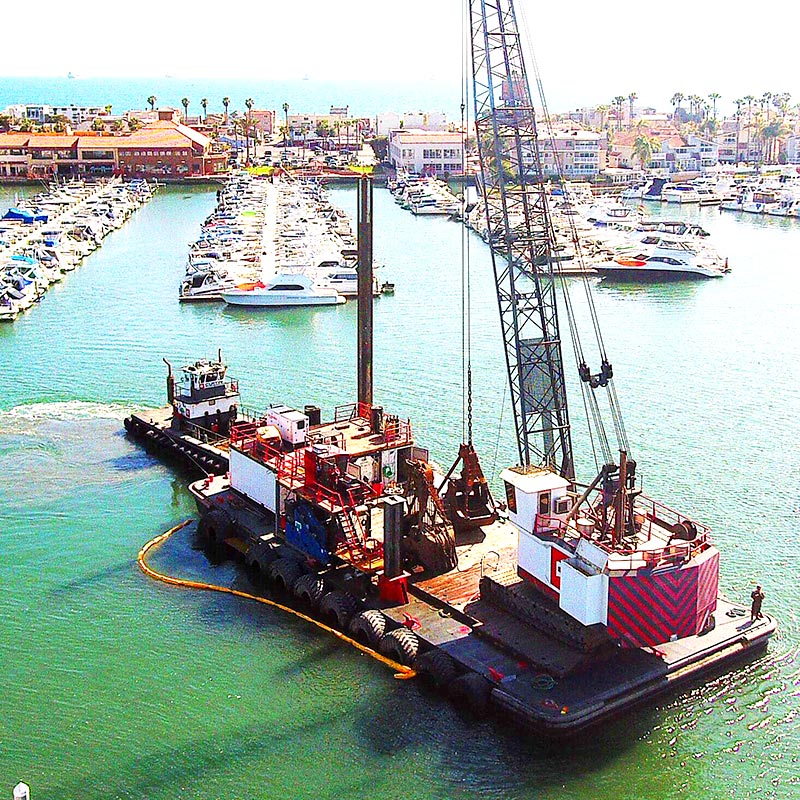Palmyra Atoll Salvage Project
The Most Remote Location on Earth.
Shipwreck Salvage + Reef Restoration
Palmyra Atoll Salvage Project
In early 2013, Curtin Maritime was approached by Global Diving and Salvage to create an executable plan for a shipwreck removal project at the remote locations of Palmyra Atoll and Kingman Reef, approximately 1000 miles due south of Hawaii.
Project Facts
• Pounds of wreckage removed: 1 million
• Total cost: $5.5 million
• Miles traveled: 6,500
• Days to complete removal: 79
• Crew: 12
• 618,350: weight in pounds of largest wreck removed
• 277,800: pounds of debris that had to be gathered by hand
• Hours spent underwater: 880
Source: U.S. Fish and Wildlife Service, Curtin Maritime
The client was the U.S. Fish and Wildlife Service (USFWS) and the project is part of a study and restoration effort that is removing shipwrecks from coral reefs to restore the ecosystem to its natural state. A study of the main shipwreck site, a 120’ steel fishing vessel showed that the decomposition of the steel was having adverse effects on the reef. The decomposition of the shipwreck was enriching the sea water with iron causing a specific species of coral, corallimorph, to flourish and dominate the reef. This is a condition known as black reef, due to corallimorphs dark coloration, and it can completely cover an area and suffocate the other coral species, eventually destroying the reef itself. It was tasked to Curtin Maritime and Global Diving to remove the wrecks and rescue the reefs.
Palmyra is one of the most remote places on earth and is home to some of the most diverse marine life on the planet.
Due to the extremely remote locations, the complexity of the logistics and the need for custom-built specialty equipment, this project suited Curtin Maritime’s strengths perfectly. Over a period of almost ten months, Curtin Maritime worked closely with Global Diving and U.S. Fish and Wildlife to craft a multi-staged proposal for removal of the wrecks at Palmyra Atoll and Kingman Reef. Palmyra is one of the most remote places on earth and is home to some of the most diverse marine life on the planet. The sheer isolation of Palmyra made just getting there a project in itself with an initial 2500 mile voyage to Hawaii and then the final 1000 mile leg due south to Palmyra. The transit time was measured in weeks, not days and brutal winter conditions made for tense moments with extreme storms coming out of the north Pacific. Curtin crew left our home dock on Sept 17th, 2013, and after a 2-week layover in Honolulu Hawaii arrived in Palmyra on October 29th.

The first shipwreck was the Hui Feng, which ran aground twenty-two years ago at Palmyra. Areas surrounding the wreck beyond a mile away had already been severely affected by the black reef condition. The Hui Feng was on its side in roughly 20’ of water, approximately half of a mile from deep water and surrounded by shallow coral heads, exposed on the surface at low tide. These conditions did not allow for the ship to simply be raised and floated out, so a plan to cut the wreck into pieces for removal was implemented.
A ®Flexi Float barge with jack-up legs was used as the support platform for the diving and removal effort at the wreck site. Onboard the 20’X40’ platform was a 30t hydro crane, full shallow water dive spread, genset and all related support equipment. A path through the reef had to be identified and the barge carefully threaded through to its final destination alongside the wreck. It took days of careful mapping of the coral filed, using buoys to mark the coral heads. The ®Flexi rig was then ferried through the narrow path without further damage to any coral. To transport the pieces that were cut up for removal, and to ferry the barge into position, custom self-propelled mini barges were constructed.
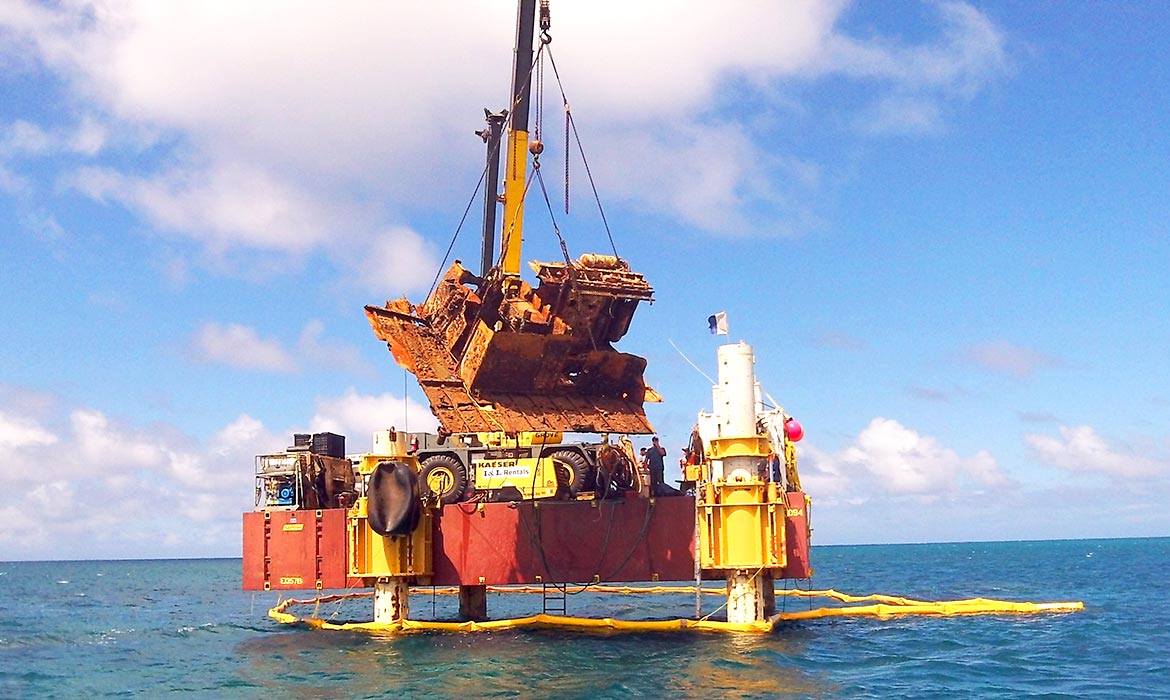
These Power Scows were designed by Curtin Maritime and built by Snow & Co. in Seattle Wa. They needed to have a light draft when loaded, extreme maneuverability and the ability to haul loads up to 13K pounds and still be small enough to operate within the coral field. The Power Scows were constructed of aluminum, 25’X10’ and were powered by a 90hp outboard. These little boats became the heart and soul of the operation serving as material transports, dive platforms and all around workboats. Rafted together, the 2 scows could transport pieces of the ship in excess of 30K pounds, delivering them to our derrick barge, the 185-3, out in deep water. Overall, some 620,0000lbs of steel and other shipwreck debris were removed.
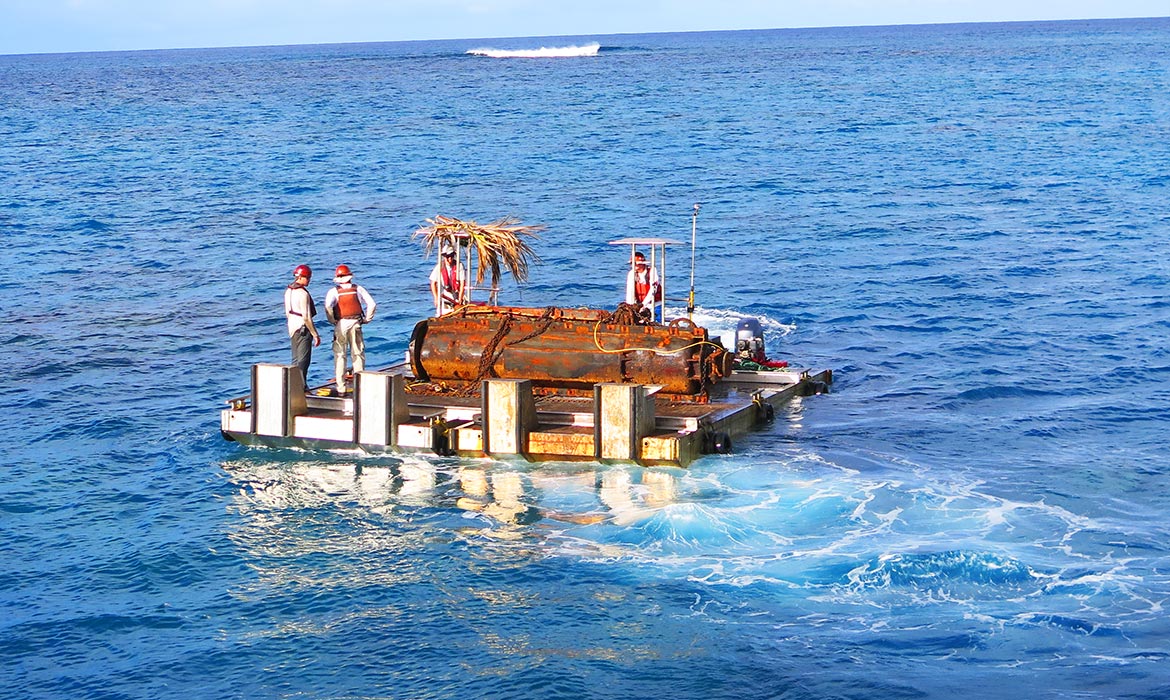
While the Hui Feng operation was underway, Curtin Maritime’s crew also began the removal of the second shipwreck at Palmyra. While Palmyra was still being used as a Naval Air Station in the early 1950s, a US Navy sectional barge that had got loose from its mooring had run aground. The barge has been reduced to rubble over the years and had been given the name “Rust Island” by FWS staff. Rust Island was in only 3’ of water and had to be accessed at high tide with one of the Power Scows. The scow used for Rust Island had a small knuckle boom crane to pick the pieces onto the scow that the crew cut and removed by hand. The total volume of steel and debris removed was 278,000lbs.

The final and most dangerous phase was the removal of an 80’ teak fishing vessel at Kingman Reef, approximately 30miles north of Palmyra. Kingman Reef was an extremely remote location, and the lack of accurately plotted navigational charts combined with volatile weather created many risks to vessel and crew safety. The fishing vessel, which went aground in 2007 had since had been pounded by storms and heavy surf, causing the wreck to break up and create a large debris field that needed to be cleared. The debris at Kingman was causing the rampant growth of invasive green algae.
The wreckage was located in shallow water and could only be accessed at high tide. After a safe route was established for crossing the reef, Curtin Maritime’s crew would drive the Power Scow through the surf line and make the transit to the debris field where items were loaded by hand and with the scow mounted crane. With persistent poor weather conditions and narrow tide windows, only one trip onto the reef a day could be done. In the 3 trips made 44,000lbs of steel, teak and fiberglass were recovered from the reef.
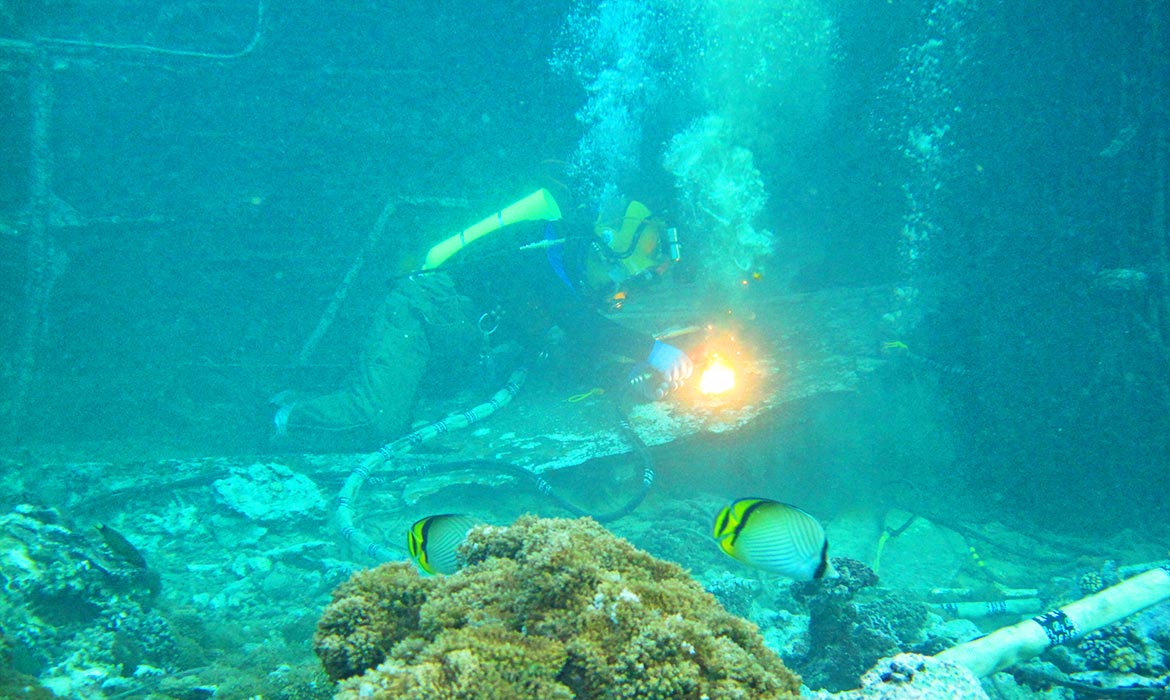
The final and most dangerous phase was the removal of an 80’ teak fishing vessel at Kingman Reef, approximately 30miles north of Palmyra. Kingman Reef was an extremely remote location, and the lack of accurately plotted navigational charts combined with volatile weather created many risks to vessel and crew safety. The fishing vessel, which went aground in 2007 had since had been pounded by storms and heavy surf, causing the wreck to break up and create a large debris field that needed to be cleared. The debris at Kingman was causing the rampant growth of invasive green algae.
The wreckage was located in shallow water and could only be accessed at high tide. After a safe route was established for crossing the reef, Curtin Maritime’s crew would drive the Power Scow through the surf line and make the transit to the debris field where items were loaded by hand and with the scow mounted crane. With persistent poor weather conditions and narrow tide windows, only one trip onto the reef a day could be done. In the 3 trips made 44,000lbs of steel, teak and fiberglass were recovered from the reef.

The operation was deemed a success by all involved, and the project was completed without injury or incident. The environment and technical specifications of this job were particularly challenging and required extensive attention to detail. In this remote location, there were many threats to the successful completion of the project, but Curtin Maritime took well-calculated steps to ensure the safe and efficient removal of risk to our vessels and crew, as well as to eliminate any further damage to the coral reefs.
For more information on this project, please see our Press page.
Contact us to see how we can assist in your salvage or marine restoration project. Contact Us >
See more projects like this Our Work


